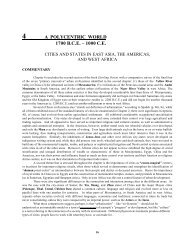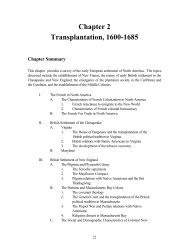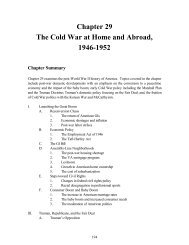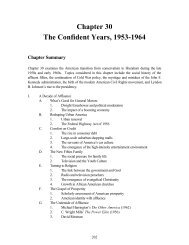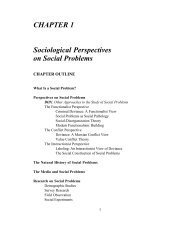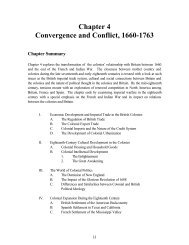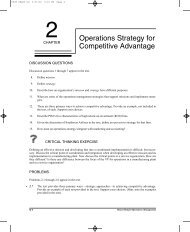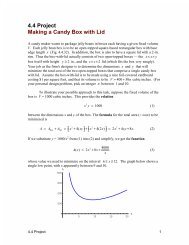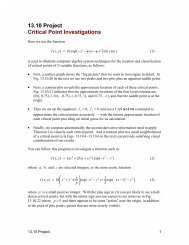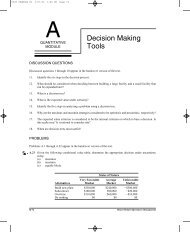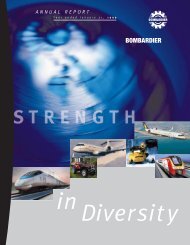Merchandising Operations and the Accounting Cycle - Pearson
Merchandising Operations and the Accounting Cycle - Pearson
Merchandising Operations and the Accounting Cycle - Pearson
Create successful ePaper yourself
Turn your PDF publications into a flip-book with our unique Google optimized e-Paper software.
Before launching into merch<strong>and</strong>ising, let’s compare service entities, with which<br />
you are familiar, to merch<strong>and</strong>ising companies. The following summarized financial<br />
statements will show how <strong>the</strong> two types of companies are similar <strong>and</strong> different:<br />
SERVICE CO.*<br />
Income Statement<br />
For <strong>the</strong> Year Ended June 30, 2002<br />
Service revenue ........................ $XXX<br />
Expenses<br />
Amortization expense ........ X<br />
Salary expense ..................... X<br />
Net income............................... $ X<br />
SERVICE CO.<br />
Balance Sheet<br />
June 30, 2002<br />
Assets<br />
Current assets:<br />
Cash....................................... $X<br />
Short-term investments...... X<br />
Accounts receivable, net..... X<br />
Prepaid expenses................. X<br />
* Such as Air & Sea Travel Inc.<br />
MERCHANDISING CO.**<br />
Income Statement<br />
For <strong>the</strong> Year Ended June 30, 2002<br />
Sales revenue............................ $XXX<br />
Cost of goods sold ...................... X<br />
Gross margin ........................... XX<br />
Operating expenses<br />
Amortization expense ........ X<br />
Interest expense................... X<br />
Salary expense ..................... X<br />
Net income............................... $ X<br />
MERCHANDISING CO.<br />
Balance Sheet<br />
June 30, 2002<br />
Assets<br />
Current assets:<br />
Cash....................................... $X<br />
Short-term investments...... X<br />
Accounts receivable, net..... X<br />
Inventory................................ X<br />
Prepaid expenses................. X<br />
** Such as The Forzani Group Ltd.,<br />
a corporation<br />
What Are <strong>Merch<strong>and</strong>ising</strong> <strong>Operations</strong>?<br />
Exhibit 5-1 shows <strong>the</strong> income statement of The Forzani Group Ltd. (FGL) for two recent<br />
years. FGL generates revenue in two different ways. Corporate revenue is revenue<br />
earned by selling merch<strong>and</strong>ise through company-owned stores. Franchise<br />
revenue is revenue earned from selling merch<strong>and</strong>ise to franchise stores, which are<br />
stores that belong to o<strong>the</strong>r owners that are allowed to use FGL’s store names, advertising,<br />
<strong>and</strong> selling expertise. In return, <strong>the</strong> franchise stores agree to purchase all<br />
inventory from FGL. FGL’s income statement differs from those of <strong>the</strong> service business<br />
discussed in previous chapters. For comparison, Exhibit 5-1 also provides <strong>the</strong><br />
income statement for Air & Sea Travel, Inc. The highlighted items in <strong>the</strong> FGL statement<br />
are unique to merch<strong>and</strong>ising operations.<br />
The selling price of merch<strong>and</strong>ise sold by a business is called sales revenue, often<br />
abbreviated as sales. (Net sales equals sales revenue minus any sales returns <strong>and</strong><br />
sales discounts.) The major revenue of a merch<strong>and</strong>ising entity, sales revenue, results<br />
in an increase in retained earnings from delivering inventory to customers. The<br />
major expense of a merch<strong>and</strong>iser is cost of goods sold, also called cost of sales. It represents<br />
<strong>the</strong> entity’s cost of <strong>the</strong> goods (<strong>the</strong> inventory) it sold to customers. While inventory<br />
is held by a business, <strong>the</strong> inventory is an asset because <strong>the</strong> goods are an<br />
economic resource with future value to <strong>the</strong> company. When <strong>the</strong> inventory is sold,<br />
however, <strong>the</strong> inventory’s cost becomes an expense to <strong>the</strong> seller because <strong>the</strong> goods are<br />
no longer available. When one of FGL’s SportChek stores sells equipment to a customer,<br />
<strong>the</strong> equipment’s cost is expensed as cost of goods sold on SportChek’s books.<br />
OBJECTIVE 1<br />
Use sales <strong>and</strong> gross margin to<br />
evaluate a company<br />
Chapter Five <strong>Merch<strong>and</strong>ising</strong> <strong>Operations</strong> <strong>and</strong> <strong>the</strong> <strong>Accounting</strong> <strong>Cycle</strong> 223



